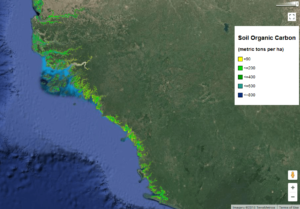New study shows mangrove forests soils hold more than 6.4 billion tons of carbon globally
The most detailed study to date of carbon storage in the soils of mangrove forests shows the high-resolution impacts of these ecosystems.
A new study of carbon sequestration in mangrove forests declares that these coastal soils store more than 6.4 billion tons of blue carbon globally. According to researchers, this is about 4.5 times the amount of carbon emitted by the U.S. economy in one year.
The high-resolution remote sensing data also indicated that destruction and degradation of mangrove forests resulted in upwards of 122 million tons of carbon released from 2000 to 2015.

A map from the study showing carbon storage in 2000 for the upper meter of soil. View full map here. (source: Woods Hole Research Center)
“Protecting, enhancing and restoring natural carbon sinks must become political priorities,” said Dr. Jonathan Sanderman of the Woods Hole Research Center, who was the lead author on the paper. “Mangrove forests can play an important role in carbon removals because they are among the most carbon-dense ecosystems in the world, and if kept undisturbed, mangrove forest soils act as long-term carbon sinks.”
The research was completed at the Woods Hole Research Center in collaboration with The Nature Conservancy. You can read more here.